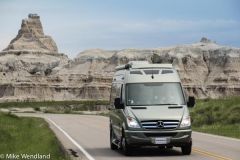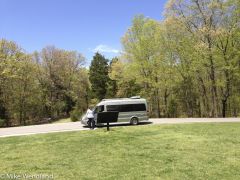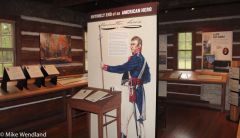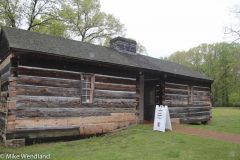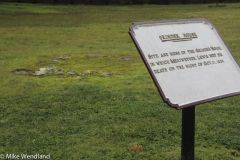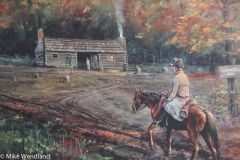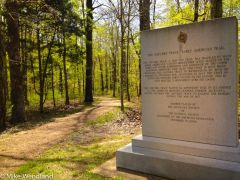-
Content Count
669 -
Joined
-
Last visited
-
Days Won
17
Content Type
Profiles
Forums
Blogs
Gallery
Everything posted by Roadtrekingmike
-
From the album: RV Must-Do Trip: The Badlands of South Dakota
-
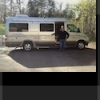
RV Must-Do Trip: The Badlands of South Dakota
Roadtrekingmike posted a blog entry in Roadtreking Blog
It’s easy to see why American Indians and the early settlers called the area of southwestern South Dakota the Badlands. They are dry, unbearably hot in the summer, rugged, isolated and - in the days before modern transportation – extremely difficult to navigate. But while it may be an inhospitable place to live, these days the Badlands make for a very good visit by RV. Jennifer and I try to spend time here each year. You could say we’ve gotten hooked on the Badlands. The Badlands National Park protects 242,756 acres of sharply eroded buttes, pinnacles, and spires blended with the largest undisturbed mixed grass prairie in the United States. There is a rugged beauty about the place like none other we have seen anywhere in North America. You will see bison, bighorn sheep and prairie dogs throughout the park, sometimes far off, sometimes surprisngly close. On the down side, you need to be snake aware out here. Prairie rattlesnakes abound. The Badlands were formed by the geologic processes of deposition and erosion. Deposition of sediments began 69 million years ago when an ancient sea stretched across what is now the Great Plains. After the sea retreated, successive land environments, including rivers and flood plains, continued to deposit sediments. Although the major period of deposition ended 28 million years ago, significant erosion of the Badlands did not begin until a mere half a million years ago. Erosion continues to carve the Badlands buttes today. Eventually, the Badlands will completely erode away. During the Age of Dinosaurs, a warm, shallow sea covered the Great Plains, including what is now Badlands. As a result, the Badlands contain one of the world’s richest fossil beds. Since dinosaurs were land creatures, no fossils of these animals have been found in the park. Giant marine lizards called mosasaurs swam in the ancient sea, along with sea turtles and fish. The park is open year round, though we seem to always visit in the summer. Temperatures can easily hit 100 degrees during the day. So we plan our hiking and bike riding in the early morning. The badlands are a photographer’s dream location. The craggy spires and wide open spaces seem to look different with every glance, every time the sun goes behind a cloud, and as the day draws to an end. Sunrises and sunsets here are spectacular. Three days and two nights are the minimum time to spend if you want to see most of the park. We always budget a visit of that long as we’re either heading west towards Yellowstone, or back home towards Michigan. Getting to the Badlands is easy. Interstate 90 (I-90) is located directly north of the park and provides access to the Hwy 240 Badlands Loop Road. For those traveling west on I-90, take Exit 131 (Interior) and follow the signs directing vehicles south approximately three miles to the Northeast Entrance. For those traveling east on I-90, take Exit 110 at Wall, South Dakota. Follow signs directing vehicles south approximately seven miles to the Pinnacles Entrance. State Highway 44 provides an alternate, scenic access to the park and intersects Highway 377 in the town of Interior. Follow 377 two miles north to the Interior Entrance. When we leave the Badlands, we prefer driving the two lanes of Highway 44 west to the Black Hills area instead of heading back to I-90. There are three campgrounds to choose from. Two are operated by the National Park Service - Cedar Pass Campground and Sage Creek Campground. Cedar Pass is located near the Ben Reifel Visitor Center and has 96 level sites with scenic views of the badlands formations. Camping fees are $18 per night per campsite, or $30 per night for campsites with electrical hook-ups. A dump station is available for a $1.00 per use fee. Cold running water, flush toilets, and covered picnic tables are available. In the summer, it’s often filled. Sage Creek is a primitive campground. You are apt to have bison wandering about the campground. It’s located on the west side of the park’s North Unit, near the Badlands Wilderness Area. Access is located off of the Sage Creek Rim Road, an unpaved road that may temporarily close after winter storms and spring rains. The road provides limited turnarounds for large recreational vehicles, but Type B and C motorhomes have no problems. Camping here is free. There is no electricity or water, but there are pit toilets and covered picnic tables. This campground rarely fills up. The third area campground is the White River KOA, located about four miles outside of the park. This is our favorite spot to stay in the Badlands. It is located in a quiet, rural area with large shade trees beside the White River. There’s a great dirt road right across the street from the campground that is perfect for bike rides Believe me, the shade of the campground is well appreciated, as is the swimming pool. The Badlands: Put it on your must visit list. And even if you have been there before, I bet, like Jennifer and me, you, too, want to keep returning. Right? -

Roadtreking Sunsets and an Urge to Hit the Road
Roadtrekingmike posted a blog entry in Roadtreking Blog
Roadtrekers love to take photos. And while our styles, skills and the things we like to photograph may vary, one thing I bet all of us like to get are images of a sunset. I’ve used these awkward days of spring before the warm weather travel season really gets under way to organize the thousands of photos I’ve taken over the past two years and 50,000 miles of roadtteking across North America. The photos could be better. But even my ineptitude is smoothed over by the awesome beauty of a sunset, whether on a beach in the mountains or a forest. Seeing them all together like this reminds me of the sound of waves on a rocky beach, the smell of cedar and pine in the northwoods, the chirping of birds and the sound of cicadas as dusk falls. I can almost breathe in the fresh air. I feel my neck muscles relax and all the tension of another busy day let go. I look forward to campfires and starry skies, early morning coffee outside the Roadtrek on a dew-covered picnic table, long walks amidst wildflowers and aspen, gazing at the majesty of the snow capped mountains and watching my dog, Tai, straining to hear sounds deep in the woods, his nose sampling scents I can’t begin to comprehend. It’s time to hit the road. Ahhhhh. Here’s a brief slideshow that hopefully will get you as excited as I am to once again get out there. -

The Mysterious Death of Meriwether Lewis along the Natchez Trace
Roadtrekingmike posted a blog entry in Roadtreking Blog
One of the great joys of traveling North America in an RV is the way it connects you to history and the people and places that have shaped us. So it was for us when we came to a historic site along the famed Natchez Trace where American explorer, soldier, and public administrator Meriwether Lewis – best known for his role as the leader of the Lewis and Clark Expedition with William Clark – met his death on October 11, 1809 under highly suspicious circumstances. He was 35 years old at the time, and his death by two gunshots remains one of the greatest unsolved mysteries of all time. Was it suicide or murder? The Natchez Trace Parkway is administered by the National Park Service and it has a Meriwether Lewis Memorial on the site where the famed explorer died. The Trace itself, meanwhile, is a meandering two-lane 444-mile drive through exceptional scenery and 10,000 years of North American history. It’s worth an RV trip all by itself. Give yourself a week to fully explore. Stretching from Natchez, MS to just south of Nashville Tenn., it was an interstate before there were interstates, used by American Indians, settlers, bandits, fur traders and armies. The Old Trace played an important role in American history. Today, visitors can enjoy not only a scenic drive but also hiking, biking, horseback riding, and lots of camping spots all along the Trace. There are lots of scenic pullouts but the one that captivated us the most was the Meriwether Lewis site. You’ll find it just off the Trace Parkway, south of Nashville, southwest of Columbia and east of Hohenwald, Tenn. The memorial site occupies a 900-acre tract that contains Lewis’ grave, a monument that the State of Tennessee erected in 1848, a “reasonable facsimile” of the Grinder’s Stand tavern/inn that the CCC built in the 1930s, and other visitor use facilities, including restrooms, a picnic area, hiking trails, and a beautifully wooded no-fee campground with 31 no-hookup sites. I’d suggest overnighting there. You can still hike parts of the old Trace and easily imagine what it was like back when Lewis met his fate there. That facsimile of the tavern now contains a great interpretive center that lets you review the highlights of the famed explorer’s life, look at photos and review eyewitness statements and official reports that document the bizarre circumstances of his death. If you start your research on the site itself, you’ll have first hand information to the basic facts: After the Lewis and Clark expedition concluded, then President Thomas Jefferson – a close friend of Lewis – rewarded Lewis with the governorship of the Upper Louisiana Territory. As the presidency changed, so did politics. Several of the bills that Lewis submitted to the Department of War for payment were questioned, leaving Lewis personally liable for those bills. So, on the last trip of his young life, Lewis set out from St. Louis (the capital of the Upper Louisiana Territory) toward Washington to defend them. Part of Lewis’ route took him along a portion of the Natchez Trace. During the early morning of Oct. 11, while staying in Grinder’s Stand, Lewis died of gunshot wounds. The evidence that exists leads most historians to conclude that Lewis’ wounds were self-inflicted, and many who knew Lewis believed he had committed suicide. Some accounts dated 1848 and later suggest that Lewis may have been murdered. As an old investigative reporter, I read all the statements on display at the museum from those who were with him. There were major holes and inconsistencies. It seemed as if Lewis was behaving irrationally at the Inn. But the account of the shooting left me scratching my head. For one thing, he was shot twice. Lewis was an expert marksman. He was shot once in the head, once in the chest. And he apparently had some unexplained knife wounds. Obviously, I am not alone in being skeptical of the suicide ruling. Lewis and Clark historians and devotees have debated for decades about what caused it. Was it suicide? Was it murder? Was it assassination? Various theories have been bandied about, but there continues to be no consensus. The descendants of Lewis have asked the Park service to exhume his remains. In 2009, they sent up a website called “Solve the Mystery” to garner support. It has not been updated since late that year. The reason the case is so puzzling is because it has officially been ruled a suicide and, later, a murder. The suicide verdict came very fast after talking with those at the Inn the night he was shot. Some 39 years later, though, his body was exhumed and a local coroners jury determined it appeared to be a murder. Here are some of the reasons many think it was murder, as reported in website called Criminal Element: Perhaps the best and most objective pieces I have read on this came from the Smithsonian Magazine and features an interview with a descendant of the explorer. Apparently, there will be no exhumation. Since Lewis is buried in a national park, the National Park Service must approve. They refused the request in 1998, citing possible disturbance to the bodies of more than 100 pioneers buried nearby. In 2008 the Department of the Interior approved the exhumation, but that decision was rescinded in 2010 upon policy review, and the Department stated that its last decision is final. See why this is such a fascinating place to visit? Just another one of the fascinating places we have discovered as we’ve traveled the country in our motorhome. -

Jennifer looking over some of the signs explaining the historic site
Roadtrekingmike posted a gallery image in Members Gallery
From the album: Meriwether Lewis Memorial on Natchez Trace Parkway
Jennifer looking over some of the signs explaining the historic site -

Meriwether Lewis Memorial on Natchez Trace Parkway
Roadtrekingmike added images to a gallery album in Members Gallery
-
From the album: Meriwether Lewis Memorial on Natchez Trace Parkway
The Park Service interpretive center -
From the album: Meriwether Lewis Memorial on Natchez Trace Parkway
You can read the original reports of those present when Lewis died. Photographed at the interpretive center. -
From the album: Meriwether Lewis Memorial on Natchez Trace Parkway
The Park Service interpretive center is located in a replica of Grinder House. -
From the album: Meriwether Lewis Memorial on Natchez Trace Parkway
What’s left of Grinder House -

Artist’s depiction of Lewis approaching Grinder House
Roadtrekingmike posted a gallery image in Members Gallery
From the album: Meriwether Lewis Memorial on Natchez Trace Parkway
Artist’s depiction of Lewis approaching Grinder House, the Inn where Lewis would die. Photographed at the interpretive center. -
From the album: Meriwether Lewis Memorial on Natchez Trace Parkway
You can still walk parts of the original Old Natchez Trace. -
From the album: Meriwether Lewis Memorial on Natchez Trace Parkway
The Meriwether Lewis Memorial -
From the album: Meriwether Lewis Memorial on Natchez Trace Parkway
Lewis how he looked near the time of his death. Photographed at the interpretive center. -
The snow is gone and the 5-foot-high banks that formed a wall along the driver’s side of our Roadtrek eTrek has melted away. As I look at it sitting there on it’s special little apron in the driveway, I can almost hear it calling: “Take me someplace fun. Now.” When I snapped this photo yesterday, it got me wondering how and where most of you keep your RVs when at home. Most of the bigger Type C and Type A’s, of course, need to have lots of room, and that usually entails a storage facility. But Type B’s can often be kept at home in the driveway, unless there are special zoning or neighborhood association rules prohibiting it. Because I drive the Roadtrek as a second vehicle when we’re at home, ours gets almost daily use. That keeps critters like mice and squirrels from claiming it as theirs during long periods of inactivity. Lately, I’ve used it as a wildlife blind, sitting inside and taking photos of the deer and turkeys that seem to think our landscaping is the animal world’s equivalent of a Golden Corral. A year or so ago, I hired an asphalt crew to add on a parking area for it. This year. I’m thinking of having an electrician put in a 30-amp box next to it. That would be for Roadtreking friends who visit. So, where do you keep your RV? Our eTrek sits in the driveway, waiting to head out.
-
Yuck. Nothing tastes worse that the first sip of water through a just de-winterized RV’s plumbing system on the first trip of the year. That’s why it is important to sanitize that fresh water tank. And for that, there are lots of different approaches. Everybody seems to have their favorite way of sanitizing the fresh water system. Roadtrek Motorhomes has a suggested way, though. Here it is, lifted from the instruction manual for the eTrek we use. There are similar instructions for all Roadtrek models. Find yours by clicking to roadtrek.com/manuals.aspx and then reading the section on de-winterizing. Some people will disagree with this and think it overkill. Others will say it’s not enough. But for me, this is what I plan to do. Note: If you follow this completely, it takes a lot of time, ideally a couple of days at least. And this is for the fresh water system. Your hot water system also needs to be de-winterized. But since there are so many differences in the way the different models heat water, you can look up your recommendations in the manual specific to your vehicle. Roadtrek suggests a two step fresh water sensitization process: First step You will need 2 gallons of water and 1 cup of fresh bleach. (Bleach loses its potency over time; always start with bleach that is less than 6 months old.) Mix up two gallons of water and one cup of chlorine bleach. Add to the fresh water fill. Allow a few minutes to drain into exterior tank. This is a good time to get some stuff for spring cleaning of your Roadtrek, so drive around for an hour. Let it sit for a couple more hours. The driving sloshes it around in the tank. That is good. When you get home again, open the drain valve and drain both tanks. This kills any bacteria in the tanks before you distribute them through the entire water system. Second step Mix 1/2 cup of chlorine with 2 gallons of water and pour into fresh water fill. Fill fresh water tank about 1/2 full. Add 1/2 cup of chlorine and fill fresh water tank about 3/4 full. Turn on water pump, circulate through entire system. Run water out of every faucet and shower head until you smell chlorine. With the water pump on, open the city water valve, and let the pump push water through the fill line for a minute or so. Run the galley faucet for several minutes. If you smell chlorine, your system is safe to use. If you do not smell chlorine or your water is foamy, or has a pungent odor, repeat this step. Drain completely, fill fresh water tank with clean water, run all faucets for 2 to 3 minutes each. To help get rid of the residual chlorine smell, pour a cup of vinegar into the fresh water tank, fill, let sit for a few hours, run the faucets for a minute or so apiece, drain the tank to ground, and refill with fresh water. There you go. Let us know how it works for you or what your process of sanitizing happens to be.
-
I’m lucky. To tend to the mechanical work on my Roadtrek eTrek on the Sprinter chassis, I have two great technicians: Daryl and Josh. Plus Eric, a great service manager who always manages to squeeze me in. I was just in the other day after a check engine light came on. Wouldn’t you know, it was one of those erratic issues. When I drove it into Hoekstra Transportation in Troy, MI, I felt somewhat sheepish. The warning light had something to do with a sensor that we had replaced about 20,000 miles ago. “That shouldn’t be causing you issues again,” said Daryl. Eric agreed. I’m driving it back in next week and they will replace a whole rail on which it is mounted. What I really appreciate about Daryl and Josh – they are both Sprinter mechanics – is that they always take the time to bring me back in the shop and show me what’s going on under the hood. I have had very limited issues with my Sprinter. I do regular maintenance and oil changes and I only wish that these guys could take care of my car, too. My experience with having my Roadtrek engine and mechanical serviced so well got me thinking about how lucky I am. The sad fact is, not all service places are as skilled, honest and ethical as the one I am blessed to use. Here are my five suggestions on how to make sure your RV has a good mechanic. Search for shops that are certified to do repairs on your engine and/or chassis. Check the manufacturer’s website, look for local dealers and ask the service manager what certifications and specialties their techs have. Check review websites. Ask your RV dealer for recommendations on where to have the vehicle’s engine serviced. They should be able to steer you to the place they use. Try to meet the tech who will be working on your vehicle personally. Ask questions. Most like sharing knowledge and since you are going to be building a long term relationship, familiarty brings respect. Make sure you have your vehicle maintained and serviced as per the manufacturer’s instructions. Tell them where your next trip will be, what the terrain and dust conditions will be like. They’ll know what to inspect for and may have some great suggestions on how to operate your RV in those areas. Call for an appointment instead of just showing up and demanding service. In an emergency, of course, a reputable place will gladly check things out. But even then, try to call ahead of time and give them as much advance notice so they know what’s coming in. Keep all your documents and service records. A good shop, of course, will have them on their computer. But if you find you need service on the road, being able to show vehicle records will help avoid unnecessary repairs and save time with a new mechanic or service center. What would you add to this list? Daryl Brown of Hoekstra Specialty Vehicles in Troy, Mich., running the Mercedes diagnostic check on my Roadtrek.
-
Thanks to the Internet and email, text messaging and Facebook updates, it’s easy to stay in touch with friends and family while traveling. But a very active group of RVers takes such connectivity to a whole new level, out-Interneting even the Internet when it comes to being able to communicate with the world. They take their own radio stations with them. They are members of the Amateur Radio Chapter of the Family Motorcoach Association and their radio stations are ham radio transceivers that let them communicate with other ham operators from their motorhomes and, during the off season, from their sticks and bricks homes. Amateur radio is not the same thing as CB, or Citizen’s Band radio. CB radio is short-range, low-powered communications and mostly used by truckers and highway drivers these days. It’s noisy, undisciplined and often plagued by interference and rude or profane language. Amateur radio is just the opposite, a popular hobby and service in which licensed “ham operators” operate communications equipment using a variety of forms, from voice to Morse Code to digital. To become a radio amateur, operators must demonstrate basic knowledge of radio technology and operating principles and pass an examination to get a Federal Communications Commissions (FCC) license to operate on radio frequencies known as the “Amateur Bands.” These bands are radio frequencies reserved by the FCC for use by ham radio operators. Ham frequencies can connect amateurs from across the street to across the world. Besides just talking and visiting with their on-the-air friends, many radio amateurs donate their time and equipment for public service work during times of emergency or disaster. I’ve been a ham operator since 1962 when, as a teenager, I became K8ZRH, my ham radio call. Over the years, I’ve been in and out of the hobby. For a while, I was obsessed with “chasing DX,” or making contact with different ham operators all over the world. I earned certificates for working amateurs in all 50 states, then from over 100 counties. I learned and mastered Morse Code, the language of transmitted dots and dashes. I built all sorts of different antennas, bouncing signals of satellites, even the moon. I embraced computer technology, joining my ham radio transceiver to my computer and using digital communications. I got involved in contesting, or radio sport as its sometimes known. There are ham radio contests almost every weekend in which hams try to make contact with operators under all sorts of conditions, such as using emergency battery or solar power and trying to accumulate as many contacts as possible in a specific period of time. The contests are training exercises, really. First and foremost, amateur radio is a service. If normal communications should ever fail, ham radio operators are practiced and ready to donate their time and expertise to keep the nation in touch. That’s the great thing about ham radio, there are so many fascinating activities and services you can tap into. Lately, it’s that public service aspect that has taken up most of my ham radio time. The first accessory I added to my motorhome when I started my RVing adventures was a ham radio transceiver. I’m part of my local community’s Amateur Radio Public Service Corps, which works with the Department of Homeland Security, to provide emergency communications when needed. I’ve taken special classes from meteorologists to be a severe weather spotter, something hams do when bad weather threatens to provide trained observers during weather warnings. And I’ve embraced ham “Nets,” short for Networks, or groups of stations that gather on a specific frequency at a set time to exchange communications. That’s how I discovered the FMCA Amateur Radio Chapter. The group runs communications Nets Monday, Wednesday and Fridays, gathering at 1 PM Eastern Time from all across the country. A Net Control volunteer coordinates check-ins and directs one station to talk at a time. Conversation typically revolves around the main interests of the members, motorhome travel and amateur radio. It’s like an RV rally on-the-air. Members chat about modifications they’ve done to their motorhomes, their radios, antenna systems and, of course, the weather. The chapter also has a website at http://fmcaarc.com that pinpoints the mobile or fixed locations of many of its 86 members on a map. And just like other FMCA chapters, they attend FMCA rallies and campouts throughout the year. Les Wright, is the chapter president, known to his fellow hams by his call sign AA7YC. He and wife, Carole, have been fulltimers since 2002, traveling the country in a 36-foot 2009 Alpine Coach. They are Nevada residents with longtime friends and family in the Reno area and usually spend a few weeks there each year. But with kids and grandkids in New York, North Carolina, Nevada, and California, they are on the road more often than not. Les has been a huge evangelist for both motorhoming and amateur radio. “The two go together hand in hand,” he said. “We get to stay in touch all the time and stay connected with what people are seeing, where they are going, instead of once or twice a year when we meet at rallies.” Les and Carole are both licensed and both participate in the radio contacts throughout the week. Their “radio shack,” as hams call their equipment room, connects through a computer in his motorhome with a transmitter stowed in the storage “basement.” He travels with several antennas, including one that mounts atop a telescoping flagpole attached to the back of the coach. “For us, being fulltimers, amateur radio has been a great way to have community wherever we go,” says Carole. For Karla and Larry Dayhuff (FMCA #) from Lecanto, FL , meeting the Wrights was infectious. Larry, had been a ham radio operator years before but was inactive. After being exposed to the FMCA Amateur Radio Chapter, he once again plunged into the hobby full tilt, even going so far as to study and pass the stringent exam for the most advanced ham license there is, Amateur Extra Class, N7LWD. Larry is now chapter Vice President. Wife Karla studied and obtained the General Class license, K4KLD, which allows her to operate on all ham bands. She’s the chapter Secretary and Membership Chair. They travel extensively in a 2006 Monaco Windsor and use amateur radio on the road from their motorhome and their Florida home. “We love the community we’ve met through RVing and ham radio,” she says. “We have met so many new friends.” Community. That’s a word you hear a lot from ham operators. Amateur radio is a very social pastime. While many are attracted by an initial interest in the technology and electronics that make two-way radio communication possible, most amateurs just enjoy “ragchewing,” or casual conversation with friends – friends who may just happen to on the other side of the continent, or world. And when you add in RVing and motorhome travel, there’s no shortage of fun things to talk about. Till next time, as the ham operators say ...73. (73 is the ham radio term for “Best Regards.”) FMCA membes Les and Carol Wright at the controls of their ham radio station in their 2009 Alpine Coach motorhome. This is my VHF/UHF ham rig mounted in my Roadtrek eTrek.
-
Over the last week, I’ve been organizing the thousands of photos I’ve taken over the past few years and noticed that I have a pretty good collection of animal crossing signs. Like a lot of people, I love seeing wildlife while Roadtreking. Somehow, I started taking photos of them as we traveled. From there, well, it sort of evolved into all sorts of signs about critters … of all sorts. Since I had them all organized, I thought I’d put them together in this little slide show. I know. taking photos of critter crossing signs is a weird hobby. Do you do anything like that? Collect photos of certain things or themes?
-

RVing's Dirty Little Secret: Filthy Campgrounds
Roadtrekingmike posted a blog entry in Roadtreking Blog
People wonder why we prefer boondocking over campgrounds. Here’s why: Too many campgrounds are dirty. Not all. But way too many. In the bathrooms, there are almost always spiders, bugs, things in the toilets and stalls that disgust you, broken windows, mold, rusty pipes, grimy sinks. In Mississippi earlier this year, one of the showers I used this year had a cracked floor. When you stepped on it, blank gunk seeped out around your feet. In Missouri, a long broken and unrepaired window had the restroom filled with moths, beetles, flies and mosquitos. In Nebraska, a campground where we stayed last summer had clogged toilets. The dump station black water tank was overflowing. Then there are the lots. Too often they are worn and trampled dirt that turns to mud every time it rains, with no grass or concrete. In Estes Park, CO, last year, a supposedly top-rated campground put us in a gravel parking lot. Five minutes after we arrived, our coach was covered in dust and we had to shut all the windows. I complained and the owner told me he makes an extra $20K a year putting people on the gravel when his other spots are filled and it’s worth the complaints to get the extra cash. AT least he was honest. The utility hookups at many parks need to be checked as way too many deliver erratic power. Water faucets drip. Dog droppings are uncollected and litter the edges of the camping spaces. It’s our experience that private campgrounds are generally the worse, though we’ve noticed that budget cutbacks in state and county parks have fewer people doing maintenance and clean up in government-run parks, too. So we boondock. While on the way to a destination, a Walmart or Cracker Barrel parking lot is usually preferable to a campground, we have found. Our Roadtrek eTrek has its own shower, its own bathroom and provides its own electricity. The campground guide books and apps are not much help. We’ve found campgrounds rated by the guide books at four stars to be pig styes. I have long suspected that the higher the rating, the more the campground spends on advertising. Maybe not. But the discrepancies of what we’ve experienced and what the guidebooks say are too often too far apart. Reviews from other campers help. But generally, we avoid most campgrounds. This Colorado campground puts you in a dusty parking lot. Nice shower, huh? The water that came out was rust covered. A broken window in a campground restroom in Missouri.- 1 comment
-
- dirty rv park
- campground reviews
- (and 5 more)
-

If Headed to Florida, Better Learn Pickleball
Roadtrekingmike posted a blog entry in Roadtreking Blog
Actually, amend that headline. Pickleball is everywhere. In fact, its leading proponents claim it is the fastest-growing sport in North America,.though verifying that is not easy to do. But there is no doubt that the sport, invented in 1965, is now hugely popular, particularly among retirees and in campgrounds, RV resorts, retirement communities and the like across Florida and the Sunbelt. Further, many snowbrird return to their northern homes each spring and bring their love of the game back with them. There are no numerous places to play in all 50 states and there are regular tournaments sponsored by its own official organization, the USA Pickleball Association. Here’s one of their promotional videos showing how the game is played: Pickleball leagues are everywhere. On our RV trip to Florida and the Gulf Coast earlier this year, I was stunned to see it played – enthusiastically – at just abut every place we visited. In case you have never heard of it, pickleball is a racket sport in which two to four players use solid paddles made of wood or composite materials to hit a polymer perforated ball over a net. A pickleball court is the same size as a doubles badminton court and measures 20×44 feet. In pickleball, the same court is used for both singles and doubles play. The net height is 36 inches at the sidelines and 34 inches in the middle. The court is striped similar to a tennis court with right and left service courts and a 7-foot non-volley zone in front of the net (referred to as the “kitchen”). Courts can be constructed specifically for pickleball or they can be converted using existing tennis or badminton courts. It was invented on Bainbridge Island, a short ferry ride from Seattle, WA. U.S. Congressman Joel Pritchard and two pals, Bill Bell, and Barney McCallum, are credited for creating the game after their kids at the time became bored with their usual summertime activities . Their kids apparently grew tired of the game. But the adults loved it, taught it to their friends and, as everybody aged, it kept growing and growing. There are two stories about how the sport got its name. The most popular story has it that the Pritchard’s dog, named Pickles, was always chasing after the wiffle ball when someone hit it out of bounds and then hiding with it in the bushes. Thus, for the game resumed, someone had to retrieve “Pickle’s ball.” But Joel Pritchard’s wife, Joan, told one interviewer that the game reminded her of the pickle boat (in crew), where oarsmen are picked from the leftovers of the other boats. The game was subsequently named pickleball. The Pritchard’s dog was actually named after the game, she said. Whatever, pickleball is a way of life for many. At an RV resort in Okeechobee, FL, where I took the above photo in this post, they had two courts that had people standing in line waiting to play from just after sunup till noon, and again just before sunup when the day’s heat eased until it was too dark to play. The resort said pickleball was so popular that they were rushing to build more courts. So there you go sports fans. Give it a try. I only had a chance to play a few minutes but from that brief experience, I can say it’s pretty darn fun. -

Protecting Your Sticks-and-Brick House While You’re RVing
Roadtrekingmike posted a blog entry in Roadtreking Blog
We’ve been traveling about two weeks out of every month and a nagging worry that doesn’t go away is the safety and protection of our sticks-and-bricks house. So this past week, I just installed an alarm system on every door, every window, as well as motion detectors, water detectors, freeze monitors and carbon monoxide and fire alarms on both levels of our two-story home. All of the alarms are monitored 24 x 7 and I have a remote app for my smartphone and computer that lets me check in on what’s happening back home. The system I got is from a relatively new company called SimpliSafe. They have been doing a lot of advertising and promotion and they won me over with the ease by which I could install everything and, should we move from our sticks and bricks home, I can easily take it with me. By the way, I have no connection with SimpliSafe. I purchased they system at full retail I paid around $800 for everything. Your cost may be less, depending on how many doors and windows you have. They just happen to be the company I choose. You can look around and pick the best company for you. I’m just sharing my solution here. My whole system is wireless. Batteries in the various sensors last for years. And the master control system uses cellular technology to stay connected to the monitoring company, meaning a burglar can’t just cut a wire and disable a system, as thieves often do with conventional alarm systems. I get an email and text alert if any alarm trips or should one of my sensors fail. Here’s a video from the company that shows how easy it is to set up. While the alarm system really adds to our peace of mind while traveling, it’s just one part of our home protection plan. When we travel, I let my neighbors know where we are going and how long we expect to be away. They also have our cell number incase they notice anything that is not quite right. We have a friend who does a walk around every few days. We also notify our local police that we are out of town. Something else: We stop all mail delivery. Years ago, on a long trip, we didn’t. A thief saw the bulging mailbox and took the mail. Among other things, he got ahold of those blank checks credit card companies often send out and promptly write several thousand dollars worth. The thief was caught by federal postal inspectors but it taught s a valuable lesson about letting mail accumulate. We also notified all our credit card companies not to send us those checks. We pay most of our bills online and have opted for billing by email to avoid snail mail piles even when we are home. Those are just a few of the things we do to watch over our house while we’re out Roadtreking. How about you? Entry sensor -

Carbon Monoxide and Propane Issues Spike in Spring for RVers
Roadtrekingmike posted a blog entry in Roadtreking Blog
As spring and warm weather approaches, this is again the time for a semiannual spike in carbon monoxide deaths and propane issues for RVers. This week at a KOA in Nashville, a couple was found dead in their RV by relatives who drove to the campground after not being able to reach them for several days. Carbon monoxide poisoning was the cause, said authorities, caused by a their propane burner. In Washington State the week before, a propane tank explosion inside an RV east of Lacey sent a couple who lived there to an area hospital with burns. The woman suffered second- and third-degree burns in the explosion. The man suffered minor burns. Fire officials said investigation indicated a leak in the propane tank that caused it to explode. And at a Walmart parking lot in Sikeston, Mo., a couple of weeks ago,there was a propane explosion inside a motorhome while people were inside the RV. The explosion blew out the side of the vehicle. One of the occupants told officers he was trying to light the stove to provide some heat because the inside of the RV was cold when the explosion occurred. They escaped with minor injuries but their motorhome was destroyed. These three recent incidents underscore the need to make sure your RV has a working carbon monoxide alarm and that you have inspected your propane tanks and plumbing. The propane system on an RV provides heat and hot water, power for the stove and refrigerator, and fuel for barbecue grills or other small appliances. There are two basic types of propane containers and systems: Department of Transportation (DOT) cylinders and American Society of Mechanical Engineers (ASME) tanks. Travel trailers, folding camping trailers, and fifth-wheel units use two movable DOT cylinders, which are positioned vertically upright and mounted to the outside front or back of the RV. Motor homes use a single, permanently installed ASME tank, positioned horizontally, and located underneath the cabin, near the entryway. Regardless of container type, all refilling repair, or replacement must be done by certified service technicians. While you may do touchups to your RV from time to time, do not paint propane cylinders, valves, or mounting hardware. This may mask important service issues, affect valves, or result in system failure. Make sure your system is inspected at least annually by a certified service technician. They are trained to detect incorrect tank pressure, leaks, or other potential hazards, and address them properly. Do not connect your propane piping to another gas source or attempt to repair any propane-related component yourself. AmeriGas, a leading propane supplier, and the Propane Education and Research Council has issued some safety guidelines for RVers. Most RV refrigerators can keep food/beverages cold during several hours of travel without a power source. They strongly recommend that propane systems be turned off while driving. Other safety tips while traveling: Shut off propane supply valves, pilot lights, ignitors, and appliances, and have everybody exit the vehicle during refueling. Do not use range burners for heat, or any appliances for means other than their intended use. Extinguish all smoking materials any time you are near tanks, filling stations, or other equipment where gasoline or propane may be present. Turn off propane supply valves before entering tunnels or enclosed areas. Be sure to follow any postings around restricted areas, such as military bases. At the Campground: Open a window and turn on your exhaust fan when using your stove. Portable fuel-burning equipment including wood, charcoal, and propane grills and stoves should not be used inside the RV or near the entryway. The use of this equipment inside an RV can cause fires or carbon monoxide poisoning. Keep your vehicle a safe distance away from any heat source, such as grills or fire pits. Keep propane tanks and cylinders at least 10 feet away from heat sources. Any time you use portable propane appliances, such as generators or heaters, it’s important to provide for ventilation. Follow all appliance manufacturer safety instructions. If You Smell Gas: It is not “normal” for propane systems to leak. If you detect a leak—or sense a propane odor(rotten egg smell) — have it checked out immediately. Immediately put out all smoking materials, pilot lights, and other open flames. Do not operate lights, appliances, or cell phones. Flames or sparks from these sources can trigger an explosion or fire. If you are able to, safely turn off the gas supply valve on your cylinder or container. Open all doors and other ventilating openings. Immediately leave the area and call 911 or the local fire department. Before you restart or use any of your propane appliances, have a qualified service technician inspect your entire system. -
I get lots of questions and requests for suggestions and recommendations about the tech gear I use to capture and blog the reports I’m doing out on the road. I’m always adding various things, but here’s my latest update on the gear I like to take with me. My main video camera – I use the Canon XA20 Professional Video Camera. I love this camera. I got this in the fall of 2013 and have found it to be the perfect ”run-and-gun” camcorder, suitable for HD ENG work (Electronic News Gathering), event coverage, interviews, scenic shots, how-to-videos and documentary filmmaking. The camera features a 1/2.84″, 1920 x 1080 CMOS sensor that captures video at various frame rates up to 59.94p, including a 24p mode for a more cinematic feel. The integrated Canon 20x HD Optical zoom lens has a 35mm equivalent zoom range of 26.8 to 576mm and features an 8-bladed iris to render highlights in a more natural manner. It uses professional XLR audio inputs for two channel recording. I use an attached shotgun mic and a wireless mic on the two inputs. Back-up Video Cameras (Two) – GoPro Her03 + Black Edition video cameras . Waterproof, dustproof, HD and able to be strapped to anything from a helmet to the side of my Roadtrek, these cameras ges great wide angle perspectives great for action shots. There are lots of mounts. I have a helmet mount for biking and a suction cup mount for slapping on my motorhome or any flat surface. One of tjese cameras is dedicated to my drone, see below. Wireless Microphone System – Good sound is essential. I use the Sennheiser EW 100-ENG G2 Wireless Lavalier Microphone System, with BodyPack Transmitter,Plug-on Transmitter, Camera Receiver. This system is a workhouse for professional videographers and news crews. It provides video recording in the most varied recording situations, from as far as 100 feet. The ME 2 clip-on microphone is virtually invisible. The extremely small SK 100 G2 bodypack transmitter and the SKP 100 G2 plug-on transmitter as well as the EK 100 G2 camera receiver feature nine frequency banks with four directly accessible presets each. My main DSLR Camera – The Canon EOS Rebel T3i 18 MP with an 18-135 mm lens. Awesome photos, great HD video. I bought this to do still and video but now use just for stills. Since this is a bit tricky to focus for video out in the boonies, I now use dedicated video and still cameras. This camera captures images with exceptional clarity and tonal range and offers more than enough resolution for big enlargements or crops. This first-class sensor features many of the same new technologies as used by professional Canon cameras to maximize each pixel’s light-gathering efficiency. Its APS-C size sensor creates an effective 1.6x field of view (compared to 35mm format). My secondary DSLR Camera – Lately, I’ve also added the new Canon PowerShot SX50 HS 12.1 MP Digital Camera with 50x Optical Zoom. I have been stunned at the capabilities of this camera and especially how clear and crisp that 50X zoom is in geting me up close to wildlife and nature shots. This is much lighter than the T3i and is seriously vying as my always-carry camera. Main lens – Because I like photographing wildlife – big, dangerous wildlife like wolves, moose, bison and bear – I need a good telephoto. But I don’t want to have to carry extra lenses. So I got the Tamron AF 18-270mm f/3.5-6.3 Di II VC PZD LD Aspherical IF Macro Zoom Lens for Canon DSLR Cameras. This lens is amazingly compact and it works on everything from wide angles to telephoto. Bag for Cameras – After years of searching, I’ve found the perfect gear bag for my DSLR calera, videocamera, lenses, wireless mics and batteries. It also holds my 15-inch MacBook Pro. It’s the Kata PL Reporter Bag, model Pl-Rpt-30. The flap features quick release buckles for full opening or a quick top-access zipper opening for when quiet is necessary, like when you don’t want to disturb the wildlife you’re trying to photograph. The organizer pockets on the front will hold your small personal items like a wallet, passport etc. Carry comfortably with the padded shoulder strap or, when on the move, tuck the bag under your arm using the detachable handle strap. I also love my Mountainsmith Descent AT Recycled Camera Bag. It’s a backpack, er, make that a frontpack. It is held in place on your chest by a shoulder harness system. Cameras are always within easy reach but I have both hands free for balance and mobility. This can hold both my still and video cameras. Great for wilderness hikes. Computer – The MacBook Pro with Retina display. Quite simply, this is the finest computer I have ever owned. Mine is the 15-inch version, with the 2.7 GHz Intel Core i7 processor. I have 16 GB of RAM and 750 GB of flash storage. Because there are no moving parts, the the solid state flash drive boots up remarkably fast. About 20 seconds does it. Video editing software – I use Final Cut Pro X. Fast, powerful, full featured and able to handle 1080p HD video without breaking a sweat. Portable hard drive – HD video files are huge. So I carry the Seagate FreeAgent GoFlex 1TB external hard drive. I make files for each shoot, organize them on the FreeAgent and never worry about using up my MacBook Pro storage. Backup Power – There are so many things that depend on battery power. Cameras, smartphones, tablets, laptops. I bring the Mophie Powerstation XL with me on all trips. It charges anything that I have that has a USB connector. Laptop bag – The SwissGear SA1923 ScanSmart Backpack carries my computer, cables, wires, adapters, chargers, notebooks, pens, thumbdrives and more stuff than anyone would ever need. I’ve literally tried every bag out there. After years of searching, this is the best for me. Padded protection for my laptop, lots of extra compartments, quality zippers and seams, I will never use another. Smartphone – I use the iPhone 5S with 65 GB. I’ve had every iPhone since they came out and just keep coming back to them. Nothing is better. I’ve used many of the Android phones, of which I most like the Galaxy S 4 and the Note 3. Tablet – The iPad. The 4g Version 3 model. Great for apps on the road. Check my PC Mike NBC-TV reports for my favorite apps. My Network – Verizon Wireless. Verizon, I’ve found, offers the best and reliable nationwide coverage. I’ve had AT&T, Sprint and T-Mobile. None came close to Verizon in terms of coverage while on-the-road, offering 3 and 4g coverage and reliability. If no WiFi is available, I use the Verizon MiFi wireless modem to set up a 4g hotspot on the Verizon network. That lets me use my MacBook Pro for web updates, uploading photos and videos. Ham radio – I’m a long-time licensed amateur radio operator (K8ZRH) and I always have a rig with me. I travel with the ICOM IC-V85 two meter FM hand held transceiver and, permanently mounted, the Kenwood 144/440 MHz TM-V71A transceiver. I use amateur radio for emergency communications, weather monitoring and just plain chit-chatting with locals on their repeaters. I did a blog post on installing ham radio in an RV. I’m hoping to add an HF model some day soon. GPS gear – For my Roadtrek, I use the Rand McNally TripMaker RVND 7710. This has a seven inch screen and can be synced to a central site to reflect the latest in construction issues and detours. Made specifically for RVs with lots of RV-specifica data and Points of Interest (POI), it is the most accruate and easy-to-follow vehicle navigation system I’ve yet to use. For my long bicycle rides and off road exploring, I use the Garmin Edge 705. Though made specifically for cycling, it slips off the handlebars mount easily and can be carried in my pocket for hiking. My Drone – Lately, I’ve also been having a lot of fun with my own personal drone. It’s really not a drone in the sense of the military drones we keep hearing about but is a radio controlled quadricopter, the Phantom 2 with a Zenmuse H3-2D Gimbal that acts as a steadycam for the GoPro Hero 3 camera it carries. I use this for aerial shots to show scenic views and overhead perspectives of the places I blog about. I have an FPV (First Person Video) monitor attached to the flight controller that transmits back the image the camera is recording. The camera has a built in compass and GPS navigation control. Google Glass – I am one of the Google Glass Explorers, those Google invited in to experiment with its new wearable computer and am indeed experimenting with it in my Roadtreking reporting. The device is expected to go on sale in late spring 2014. Right now I use it primarily to record video and shoot still pictures. I did a review on Google Glass for my PC Mike blog and already have done a couple of videos with it for the blog and will do many more as the 2014 travel season gets underway. It has lots of apps that work with it, projecting information on a little screen right in front of your right eye. It’s connected to the Internet and uses your voice to open and close apps, share messages on social media, record messages and to answer questions you verbally ask it just as you would type them with a keyboard on the Google search engine. Clothing – I wear coats, shorts, jackets, vests, pants and shirts made by ScottEVest, an American maker of tech-enabled very high quality casual clothing that is known for having an abundance of pockets for all the tech gear one would want to carry around. The company started with a great photographer’s vest and for well over a decade, I proudly wore mine all over the world. Now, Scott Jordan, the guy behind the company, makes a whole line of mens and womens clothing. They are stylish and comfortable and perfect for all my gadgets and gizmos.
-

The Things I Like Most About My Roadtreking Life
Roadtrekingmike posted a blog entry in Roadtreking Blog
As we wait to set off on our next trip, I’m thinking about all the things I like about this new small motorhome lifestyle we have embraced. Waking up to sunlight streaming around the edges of the shades of our Roadtrek and the smell of that first cup of coffee brewing as I start the day. The first peek out the window at our surroundings. We boondock a lot so often, it’s wildlife I see. I love to sip that coffee and quietly watch the world wake up. The smell of bacon frying as I start to make breakfast on the picnic table outside. Taking Tai for his morning walk in a new campground or forest. Walking with Jennifer, exploring our surroundings, hand-in-hand Doing my morning blog work from a campchair next to the Roadtrek. Watching the landscape which unfolds like a high definition movie on the other side of the windshield as we head to our next destination. Changing our mind on route and stopping on a whim to spend the night at a spot we didn’t expect to find but looks inviting Quiet, two-lane state or county roads, the “Blue Highways” that let us see the small towns and farms and wide open spaces far off the hurried interstates. Finding a local “Mom and Pop” restaurant or market or local produce stand that lets us experience local and regional foods that aren’t pre-packaged, frozen or microwaved. Taking a nap in the middle of the day in our “look-at-the-sky” chairs outside the Roadtrek. Meeting new people who share our live of travel and the outdoors. Everybody has a story. Everybody has something to teach us. Watching a sunset from a new place. Seeing the clouds pass by in a bright blue sky, with some birds way up high coasting on the thermals. Or seeing the stars in a jet black sky far from big city light pollution. This is why we call our tilt-back chairs “look-at-the-sky” chairs. The smell of a campfire Watching the fire sitting next to Jennifer, with Tai behind us with his back to the fire. Not saying a word, just being together, content, relaxed and listening to the wood crackle and burn as it turns into a bed of hot red embers Hearing an owl late at night just before we drift off to sleep in our king sized bed atop the four inch mattress topper that makes it so comfortable. There you go. That’s my list. What would you add?


